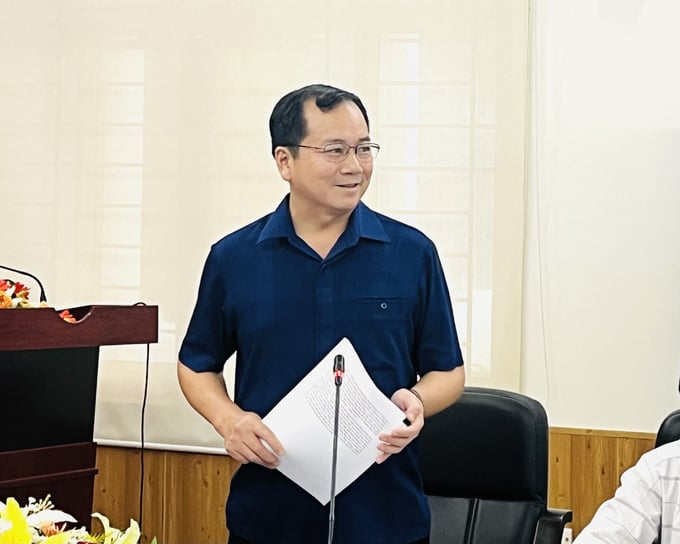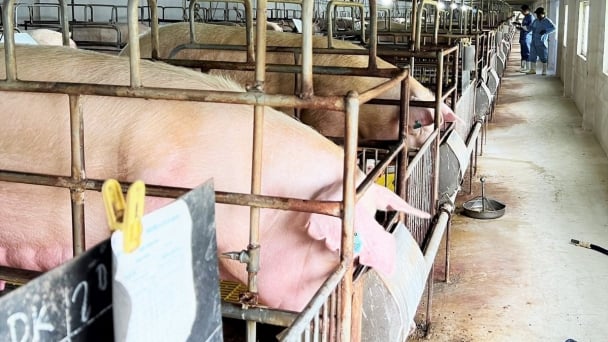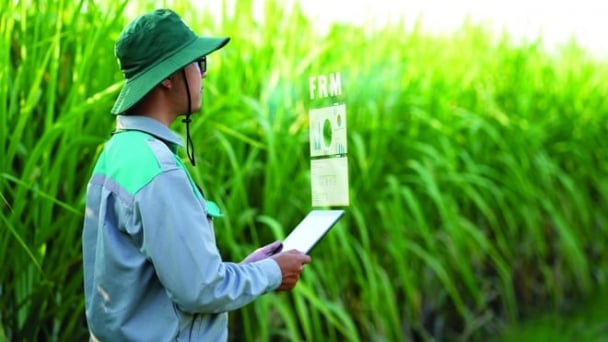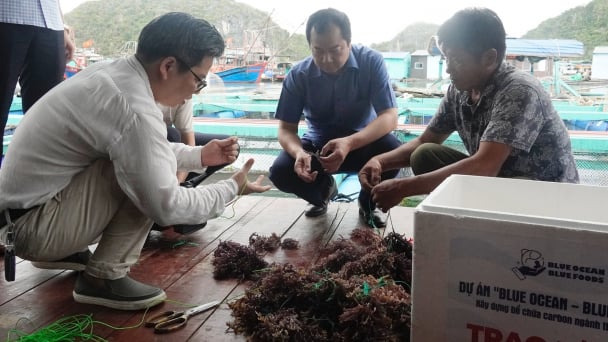May 28, 2025 | 17:25 GMT +7
May 28, 2025 | 17:25 GMT +7
Hotline: 0913.378.918
May 28, 2025 | 17:25 GMT +7
Hotline: 0913.378.918
The Department of Fisheries held a conference on July 5 to review its accomplishments in the first six months of 2023 and prepare for the last six months of 2023.
According to Mr. Nhu Van Can, Deputy Director of the Department of Fisheries, Vietnam's weather in the first six months of 2023 was relatively favorable for both farming and exploitation. Additionally, petrol prices are gradually declining, allowing fishermen to actively engage in marine exploitation. After the Covid-19 pandemic is controlled, production, export, import and consumption of aquatic products have recovered and developed relatively stably.

Deputy Minister of Agriculture and Rural Development Phung Duc Tien remarked: "Vietnam's fishery exploitation output in the first six months of the year reached more than 1.93 million tons, up 0.2%". Photo: Hong Tham.
The Department of Fisheries reported that Vietnam's total seafood production reached 4.27 million tons by the end of June 2023, which is an increase of 1.7% over the same period in 2022. Accordingly, exploitation output reached 1,934 million tons, up 0.2%; farming output reached over 2.33 million tons, up 3% over the same period last year.
Export turnover in the fisheries sector is estimated at 4.13 billion USD in the first half of 2023, which is a decrease of 27.4% over the same period in 2022. Brackish water shrimp export is estimated at 1.56 billion USD, accounting for 38% total Vietnam's total seafood export turnover; pangasius export is estimated at 885.5 million USD, accounting for 21.1% of the total export turnover.
Mr. Tran Dinh Luan, Director of the Department of Fisheries commented on the results of the fisheries sector in the first six months of 2023: "The farming output in the fisheries sector is relatively stable. However, the global economy rebounded more slowly than anticipated due to the lingering effects of the Russia - Ukraine conflict as well as the impact of the Covid-19 outbreak from the previous year. Global spending reductions and a steep decline in the demand for aquatic products have made it difficult for many countries to export seafood products. As a result, Vietnam's export turnover of seafood products in the first half of 2023 decreased by 27.4% compared to the same period in 2022".
On the other hand, the Department of Fisheries has succeeded in the management of fishing vessels. Namely, the department has effectively managed fishing vessels under the fishing license quota, and the total number of fishing vessels has decreased.
By the end of 2022, Vietnam has a total of 86,820 fishing vessels, including 38,500 fishing vessels with a length between 6 and 12 meters; 18,300 fishing vessels with a length between 12 and 15 meters; 27,500 fishing vessels with a length between 15 and 24 meters; 2,590 fishing vessels with a length of over 24 meters. The Department of Fisheries aims to reduce this figure to 86,558 fishing vessels in total by the end of 2023.
“Regarding exploitation in the fisheries sector, the two most recent inspection teams, led by Deputy Prime Minister Tran Luu Quang and Deputy Minister of Agriculture and Rural Development Phung Duc Tien, have revealed numerous restrictions, including the absence of restrooms on fishing vessels and the dumping of waste at sea; challenges in product traceability, fishing port sanitation and safety," Mr. Luan added.
Based on the state of export as well as the forecast for global consumption demand in the second half of 2023, the Department of Fisheries has set a goal for the fisheries sector to reach an output of 4.78 million tons in the last six months of the year. Namely, exploitation output is projected to reach 1.75 million tons; farming output 3.03 million tons and export turnover 5.8 billion USD.
The total output of the fisheries sector is expected to reach 9.05 million tons in 2023; including 3.68 million tons in exploitation output; 5.37 million tons in farming output with 1.62 million tons of pangasius and 1.03 million tons of brackish water shrimp; 10 billion USD in export turnover.

Mr. Tran Dinh Luan, Director of the Department of Fisheries noted that there are still numerous challenges in the fisheries sector. Photo: Hong Tham
The fisheries sector is expected to face several challenges in the second half of 2023, including: the unpredictable developments of sea weather; the 2023 rainy and stormy season; the declining resources declined in terms of quantity and quality.
According to multiple forecasts, the shrimp and pangasius industries may continue to suffer from the effects of climate change, drought, saltwater intrusion and disease outbreaks.
The state of order and security at sea is complicated and unpredictable. Namely, the fishing grounds used by Vietnamese fishermen have drastically decreased as a result of numerous countries in the region tightening their control over maritime fishing activity. In addition, the EC's yellow card warning remains a challenge for Vietnamese-caught fishery products.
According to Mr. Tran Cong Khoi, Head of the Seeds and Aquatic Feed Division, the Ministry of Agriculture and Rural Development has been proposed to guide local governments in promoting the Law on Fisheries to seed production and business establishments across the country within the last six months of 2023.
Other proposed solutions include: carrying out inspection and maintenance of broodstock production facilities; monitoring the observance of the law on seeds and feeds in terms of shrimp and pangasius in key provinces; coordinating with functional agencies to organize inspections in key provinces regarding seed and aqua feed production; strictly handling establishments that violate the regulations on production conditions.
Furthermore, the supply and demand of seeds for production must be constantly monitored, supervised and balanced to prevent a lack of seed supply from impacting production activities.
Deputy Minister of Agriculture and Rural Development Phung Duc Tien reported that the agricultural sector has a relative high GDP growth rate in the first six months of 2023, at 3.07%. Accordingly, agriculture grew by 3.14%; forestry grew by 3.43%; fisheries grew increased by 2.77%. The fisheries sector plays a significant role by accounting for 27 to 28% of the country's agricultural value.
"There are many potentials and advantages in terms of farming in the immediate future. It is necessary to review 3 million hectares of shrimp, pangasius, mollusks, etc. to identify problems and propose appropriate responses to maintain growth until the end of the year. In terms of exploitation, the output in the first six months of the year reached more than 1.93 million tons, which is a reasonable increase of 0.2%. We must be determined to achieve the target goals within the last six months of 2023", the Deputy Minister requested.
Translated by Nguyen Hai Long
/2025/05/25/4127-3-073637_820.jpg)
(VAN) Thanks to the promotion from an FAO-implemented project, vegetable production in greenhouses in Moc Chau has seen strong development, from 1.5 hectares in 2021 to nearly 50 hectares in 2024.

(VAN) FAO has recently supported USD 140,000 to implement the project 'Risk mitigation human-animal interface risks through disease control initiatives in pig farming.'

(VAN) The People's Committee of Tra Vinh province has approved an adjustment to the investment policy for the Green Hydrogen Plant project, increasing its area to approximately 52.76 hectares.
![Reducing emissions from rice fields: [2] Farmers’ commitment to the soil](https://t.ex-cdn.com/nongnghiepmoitruong.vn/608w/files/news/2025/05/05/dsc08881jpg-nongnghiep-140632.jpg)
(VAN) Clean rice cultivation model in Thuong Tan commune, Bac Tan Uyen district, is assisting local residents in achieving sustainable agriculture by substantially reducing costs, increasing productivity, and protecting the environment.

(VAN) At the conference to disseminate Resolution No. 68, AgriS introduced its digital agricultural ecosystem and reaffirmed its commitment to accompanying the Government in promoting private sector development and sustainable agriculture.

(VAN) 'Blue Ocean - Blue Foods' initiative is designed to restore marine ecosystems and establish sustainable livelihoods for local communities by cultivating a minimum of 1,000 hectares of cottonii seaweed in the first three years.
/2025/05/21/4642-3-112707_603.jpg)
(VAN) The V-SCOPE project has made direct contributions to three out of six pillars of the Comprehensive Strategic Partnership between Vietnam and Australia.